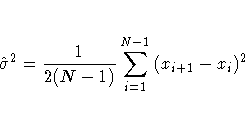Chapter Contents
Previous
Next
|
Chapter Contents |
Previous |
Next |
| XCHART Statement |
This section provides formulas for various methods used to estimate
the standard deviation ![]() . One method is applicable
with individual measurements, and three are applicable with
subgrouped data.
The methods can be requested with the SMETHOD= option.
. One method is applicable
with individual measurements, and three are applicable with
subgrouped data.
The methods can be requested with the SMETHOD= option.

Note that you can compute alternative estimates (for instance, robust estimates or estimates based on variance components models) by analyzing the data with SAS modeling procedures or your own DATA step program. Such estimates can be passed to the CUSUM procedure as values of the variable _STDDEV_ in a LIMITS= data set.

where ni is the sample size of the i th subgroup, N is
the number of subgroups for which ![]() , si is
the sample standard deviation of the observations
xi1, ... ,xini in the i th
subgroup.
, si is
the sample standard deviation of the observations
xi1, ... ,xini in the i th
subgroup.



| si | is the standard deviation of the i th subgroup. |
| c4(ni) | is the unbiasing factor defined previously. |
| ni | is the i th subgroup sample size, i = 1,2, ... ,N. |
| N | is the number of subgroups for which |
The estimate is

The MVLUE assigns greater weight to estimates of
![]() from subgroups with larger sample sizes and
is intended for situations where the subgroup sample sizes vary.
If the subgroup sample sizes are constant, the MVLUE reduces
to the default estimate (NOWEIGHT).
from subgroups with larger sample sizes and
is intended for situations where the subgroup sample sizes vary.
If the subgroup sample sizes are constant, the MVLUE reduces
to the default estimate (NOWEIGHT).

where
| ni | is the sample size of the i th subgroup. |
| N | is the number of subgroups for which
|
| si | is the sample standard deviation of the i th subgroup. |
| c4(ni) | is the unbiasing factor defined previously. |
| n | is equal to (n1+ ... +nN)-(N-1) . |
The weights in the root-mean-square expression are the degrees of
freedom ni-1. A subgroup standard deviation si is
included in the calculation only if ![]() .
.
If the unknown standard deviation ![]() is constant across
subgroups, the root-mean-square estimate is more efficient than the
minimum variance linear unbiased estimate. However, as noted by
Burr (1969), "the constancy of
is constant across
subgroups, the root-mean-square estimate is more efficient than the
minimum variance linear unbiased estimate. However, as noted by
Burr (1969), "the constancy of ![]() is the very thing under
test," and if
is the very thing under
test," and if ![]() varies across subgroups, the root-mean-square
estimate tends to be more inflated than the MVLUE.
varies across subgroups, the root-mean-square
estimate tends to be more inflated than the MVLUE.
|
Chapter Contents |
Previous |
Next |
Top |
Copyright © 1999 by SAS Institute Inc., Cary, NC, USA. All rights reserved.